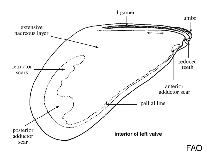Aulacomya atra (Molina,1782)
Chilean ribbed mussel
Upload your photos
Google image | No image available for this species;
drawing shows typical species in Mytilidae.
Google image | No image available for this species;
drawing shows typical species in Mytilidae.
Classification / Names Common names | Synonyms | CoL | ITIS | WoRMS
Bivalvia | Mytilida | Mytilidae
Environment: milieu / climate zone / depth range / distribution range Ecology
Benthic; depth range 0 - 40 m (Ref. 125441). Temperate; 7°C - 16°C (Ref. 78191), preferred 12°C (Ref. 107945); 11°S - 58°S, 78°W - 160°E
Distribution Countries | FAO areas | Ecosystems | Occurrences | Introductions
South Pacific, Southern Atlantic, and Antarctic Indian Ocean: From southern Brazil to Tierra del Fuego in the Atlantic and from Beagle Channel to El Callo, Peru. Also from South Africa to Namibia, Kerguelen and Macquarie Island. Introduced in UK. Tropical to polar.
Length at first maturity / Size / Weight / Age
Maturity: Lm ?, range 2 - ? cm Max length : 9.5 cm SHL male/unsexed; (Ref. 109255)
Length information from sampling in the Patagonian shelf. Collected individuals were 47-63 mm in length (Ref. 78355). Found in shallow subtidal benthic communities of two islands in Saldanha Bay (Ref. 78353) and dominated the sessile fauna of Robben Island at depths beyond 17 m (Ref. 78192). Found attached to rocky substrates, associated with holdfasts of juvenile brown algae, and may occasionally reach greater depths; may be found isolated in intertidal or forming large banks in eulittoral (Ref. 87801). It is also found in forests of Macrocystis pyrifera (Ref. 92889).
Life cycle and mating behavior Maturity | Reproduction | Spawning | Eggs | Fecundity | Larvae
Members of the class Bivalvia are mostly gonochoric, some are protandric hermaphrodites. Life cycle: Embryos develop into free-swimming trocophore larvae, succeeded by the bivalve veliger, resembling a miniature clam.
Main reference
References | Coordinator | Collaborators
SAUP Database. 2006. (Ref. 356)
IUCN Red List Status (Ref. 130435)
CITES status (Ref. 108899)
Not Evaluated
CMS (Ref. 116361)
Not Evaluated
Threat to humans
Human uses
Fisheries: commercial
FAO - Aquaculture: production; Fisheries: landings, species profile | FishSource | Sea Around Us
Tools
More information
Internet sources
BHL | BOLD Systems | CISTI | DiscoverLife | FAO(Fisheries: species profile; publication : search) | Fishipedia | GenBank (genome, nucleotide) | GloBI | Gomexsi | Google Books | Google Scholar | Google | PubMed | Tree of Life | Wikipedia (Go, Search) | Zoological Record
Estimates based on models
Preferred temperature
(Ref. 115969): 6.9 - 17.1, mean 11.6 (based on 396 cells).
Resilience
(Ref. 69278):
Medium, minimum population doubling time 1.4 - 4.4 years (K=0.16-0.42).
Nutrients: Calcium = 149 [71, 228] mg/100g; Iron = 8.53 [1.95, 15.11] mg/100g; Protein = 9.88 [8.64, 11.12] %; Omega3 = 0.313 [0.202, 0.423] g/100g; Selenium = 61 [50, 72] μg/100g; VitaminA = 0 μg/100g; Zinc = 2.04 [0.56, 3.51] mg/100g (wet weight).



